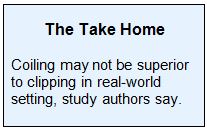Key Points:
- Study compares surgical clipping, endovascular coiling for elderly patients with ruptured cerebral aneurysms
- Clinical outcomes similar with both approaches, but length of stay longer with clipping
Surgical clipping and endovascular coiling provide similar outcomes for elderly patients with ruptured cerebral aneurysms, suggests an observational study published online August 28, 2015, ahead of print in the Journal of NeuroInterventional Surgery.
Kimon Bekelis, MD, of Dartmouth-Hitchcock Medical Center (Lebanon, NH), and colleagues looked at Medicare fee-for-service claims data on 3,210 patients 65 years and older who underwent treatment for ruptured cerebral aneurysms between 2007 and 2012. Surgical clipping was used in 37.6% and endovascular coiling was used in 62.4%.
In unadjusted analyses, clipping was associated with a lower rate of 1-year mortality (36.3% vs 41.0%; P = .008), a higher rate of discharge to rehabilitation (30.5% vs 26.3%; P = .009), and a trend toward an increased rate of 30-day readmission (17.7% vs 15.4%; P = .09). But after multivariate adjustment, there were no significant differences between groups for any of those outcomes (table 1).
Table 1. Clinical Outcomes: Clipping vs Coiling
|
|
OR |
95% CI |
|
1-Year Mortality |
0.97 |
0.83-1.14 |
|
Discharge to Rehabilitation |
1.13 |
0.95-1.34 |
|
30-Day Readmission |
1.20 |
0.98-1.47 |
Mean length of stay, however, was longer after clipping (19.9 vs 17.6 days; P < .0001). After adjustment, length of stay was 1.78 days longer with clipping.
Multiple other statistical techniques yielded similar findings.
Outcomes Differ From Those of Randomized Trials
Although prior RCTs—including ISAT and BRAT—have shown the superiority of endovascular coiling over surgical clipping, there are few data on real-world outcomes.
“Concerns have been raised that the expanding use of endovascular techniques has been driven by lower-volume centers with inferior outcomes,” Dr. Bekelis told WLNCMD in an email. “In addition, the application of these techniques in patients with age characteristics, comorbidity profiles, and aneurysm locations outside the strict criteria set by randomized trials might yield suboptimal or otherwise unexpected results.”
The lack of a difference in clinical outcomes observed in this study “might reflect the favorable risk profile of the population included in randomized trials,” Dr. Bekelis said. “Another possibility is that coiling might be associated with a higher rate of complications in elderly patients, given their tortuous vascular anatomy and calcified vessels, making endovascular access and navigation challenging. Lastly, the widespread availability of coiling options performed by multiple specialties without strict certification criteria and standardization of training might lead to suboptimal results in the community.”
But according to Scott Simon, MD, of Penn State Milton S. Hershey Medical Center (Hershey, PA), interpretation of the study is limited by the fact that the authors did not account for clinical grade or ranking of a patient’s degree of illness at presentation.
“A neurosurgeon would be unlikely to take an older patient who is very sick for a craniotomy when coiling is a reasonable option,” he told WLNCMD in an email. “The authors do not provide data on the patients’ clinical grade; therefore, we must assume that the craniotomy patients in the database are likely very low grade or not very sick. This creates a strong selection bias inherent in the data.”
Given the lack of these crucial data, the study “at best, simply reinforces that if we are very selective about on whom we perform a craniotomy for clipping, being very careful to avoid very sick or very old patients, we can achieve results equal to those of coiling every patient, including the very sick ones. Therefore, the data presented do not support the conclusion that both treatments are equivalent.”
While Dr. Bekelis acknowledged the limitations inherent in an observational study, he also pointed out that “this analysis controls for unmeasured confounders (such as subarachnoid hemorrhage grade or aneurysm location) by creating randomization of the treatment method.”
The method, he explained, is expected to balance the comparison groups and “has been used to create randomization in retrospective data in multiple high-impact publications” on topics as diverse as anesthesia technique and stroke care.
In the latter example, which used the same database as the current analysis, “the authors did not have data on the NIH stroke scale or neurologic status of the patients at presentation …, and that was the very reason they used an instrumental variable analysis,” Dr. Bekelis said. “In addition, we created a cohort of almost all elderly patients in the United States, giving a true picture of national practice in this population which was not represented in prior clinical trials.”
Source:
Bekelis K, Gottlieb D, Suet Y, et al. Surgical clipping versus endovascular coiling for elderly patients presenting with subarachnoid hemorrhage. J NeuroIntervent Surg 2015;Epub ahead of print.
Disclosures:
- Drs. Bekelis and Simon report no relevant conflicts of interest.


